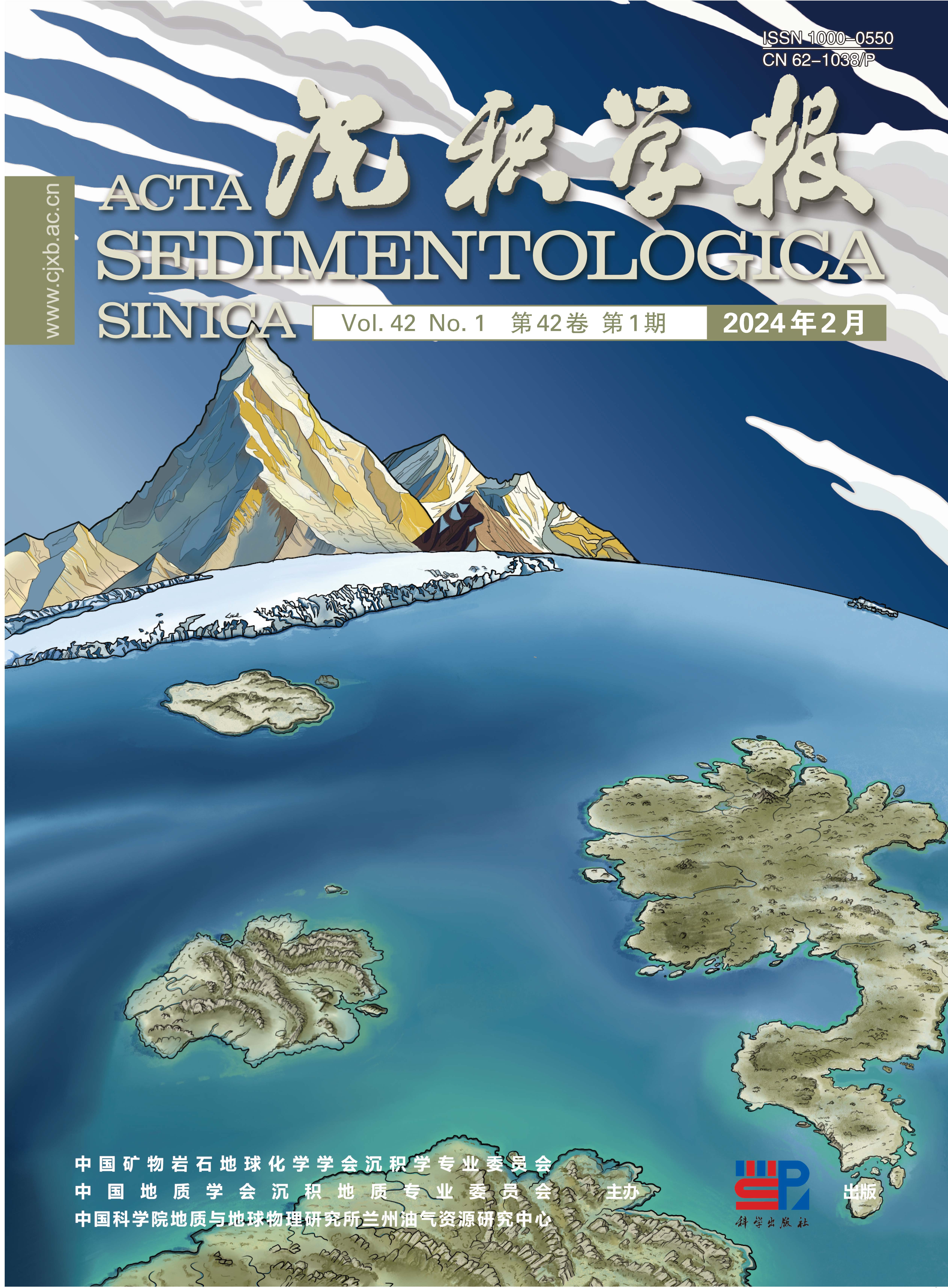HTML
-
地质历史中的核形石通常是指直径大于2 mm的碳酸盐包覆颗粒,内部常具不完整或不规则同心纹层,其组构及形态是反映古气候、水体能量、水深、微生物类群、水化学条件波动等信息的重要载体[1⁃6]。核形石时空分布广泛,前寒武—第四纪时期均有分布[6⁃7],陆相的湖泊、三角洲及海相的潮坪、浅滩环境中均有发育[8⁃11]。一般来说,具同心纹层的普通核形石微生物岩代表着水体充分搅动的高能环境,同心纹层密集、外形近于球形的能量较高;层纹数量少或外形不规则以及扁平者代表能量较低的环境[10,12]。奥陶纪时期全球发生了一次重大海洋生物演化事件—生物大辐射,对早古生代地球海洋生态系统产生了重要影响[13⁃14],且前人认为其是全球气候变冷、海平面上升、大气氧浓度增加、造山运动加剧等环境因素共同作用的结果[15⁃17]。核形石组构及成因研究可有效揭示该期环境指标及变化。
我国晚奥陶世核形石研究多集中于塔里木板块的塔中、塔北地区,核形石核心类型多样,几乎各种生物颗粒、内碎屑颗粒皆可为核,多为球状或椭球状、半圆状、复合型核形石。前人研究认为塔中、塔北地区高能环境下多形成亮晶胶结、个体大、圆度较高的核形石,中—低能环境下常形成灰泥胶结、个体小、薄皮核形石[18⁃20]。而中15井塔中西部上奥陶统良里塔格组泥质条带灰岩段中的核形石发育段具有典型的低能沉积特征,累积厚度12.3 m,核形石丰度高、粒度变化大、垂向演化规律明显。通过对该段核形石组构、粒间填充物、垂向旋回等特征的解剖,分析其形成、沉积环境与组构特征之间的响应关系,建立成因模式图,以丰富低能环境下核形石成因研究。
-
塔中地区位于塔里木盆地中央低隆起中部,东与塔东低隆相连,西接巴楚断隆,北与满加尔凹陷、顺托果勒隆起相邻,为一古生代长期继承性发展的巨型古隆起(图1a)[21]。晚奥陶世良里塔格组沉积时期,塔中处于低纬度地区,缺乏陆源物质输入,气候温暖,为开阔台地—台地边缘的沉积体系(图1b),海平面相对稳定[22],盐度正常,发育大量浅水生物、砂屑[23]。
中15井位于塔中地区西部,其上奥陶统良里塔格组厚度为325 m,自上而下分为泥质条带灰岩段、颗粒灰岩段和含泥灰岩段三个岩性段(图1c)。核形石主要发育于中15井泥质条带灰岩段中上部,见于第6至第8筒次取心段(5 136.00~5 160.54 m),岩性为含泥质条带核形石灰岩、含生屑泥晶核形石灰岩等。
-
研究基于详细的岩心观察和室内薄片、扫描电镜鉴定,统计、分析核形石宏观形态、微观组构。岩心观察中15井第6~8筒次含泥质条带核形石灰岩中核形石的粒径、含量、垂向分布位置及旋回、核形石发育与泥质条带含量的统计学等特征,定量描述并获得了各部分的参数。垂向上选取各种形态、包壳发育好/差、核心类型不一、粒间充填物不一等各类典型的核形石块样磨制薄片100余片,应用Zeiss AXIO SCOPE. A1偏光显微镜观察核形石内部组构、核形石间充填物等特征。选取50个核形石纹层样品磨制成粉末,在湿度20%、温度20 ℃条件下,应用ISOPROBE-T热电离质谱仪进行87Sr/86Sr测定,用以分析海平面变化趋势。
-
宏观上,中15井核形石形态多样,以球形、半球形、椭球形、花瓣状为主,粒径一般为8~16 mm,个别可达20 mm。核心包括暗色微泥晶碎屑团块、生物碎屑等(图2a~d);纹层多呈断续、稀疏、紊乱、似断若续状分布(图2、图3a,c,d),少数纹层见连续、紧密发育(图3b),部分具泥晶化。粒间多泥质条带、灰泥(图3)、破碎程度较高的生物碎屑充填(图3a)。垂向上,5 136~5 140.8 m段核形石连续分布,5 145.8~5 149.2 m、5 153~5 160.2 m段断续分布,累积厚度12.3 m。
-
观察显微组构发现,核形石核心组分类型多样,常见苔藓虫、腹足、双壳、珊瑚、三叶虫等生物碎屑(图4a~c)及微泥晶团块(图4d)等,成分以方解石为主,少量陆源碎屑、铁质矿物。纹层主要有暗色泥晶纹层(200~300 μm)、菌藻纹层(100~500 μm)、微亮晶纹层(50~100 μm)等三种类型,以前两者共生为主;纹层对称及非对称式均有发育,以非对称为主;纹层呈连续、断续状分布,部分呈花瓣状。菌藻纹层中见大量具明显外壁的丝状葛万菌(Girvanella),丝体极细,宽约10 μm,长50~100 μm,局部密集分布(图4e)。葛万菌形态在纹层不同部位具有差异性,外圈呈明显的顺层分布,中部圈层多相互缠绕、杂乱生长,内圈见平行或斜交纹层。泥晶纹层多断续、模糊(图4b,d)。
当核心为生屑时,因生屑核心类型、大小不同导致核心大小差异较大,核心长轴通常为8~18.4 mm,短轴通常为4~15.6 mm,核形石大小与生屑核心的形态、大小呈正相关性;此类核心的核形石纹层倾向于单侧生长,短轴方向上纹层生长速度快于长轴方向,纹层一般厚0.08~3 mm;核形石形态与核心形态基本保持一致或单侧增厚呈半球状。通常来说,当核心为生屑时,其骨骼的核心密度相对较低,易悬浮于水中,藻类、微生物等围绕生屑核心生长,捕获、黏附碳酸盐质点,应表现为全方位、明暗纹层交互生长的特征[24]。而该井以生屑为核心的核形石呈现出两种截然不同的纹层特征:一类纹层较厚、核形石个体大、呈球状或帽状,粒间往往充填泥质或泥质、破碎严重的生物碎屑(图4b);另一类纹层较薄、仅核心短轴方向生长0.08~0.4 mm的包壳、核形石个体较小,粒间往往为灰泥、少量较完整的生物碎屑充填(图4e)。表明同环境形成的生屑碎屑,因其形态和大小的差异,可经历不同的成壳过程,最终形态多样的核形石类型。
当核心为微泥晶团块和早期破碎的核形石球体时,核心形态多为轻微不规则状或椭圆状,粒径一般较小(1.5~6.12 mm)。此类核心最终形成的核形石个体大,约6~15 mm,形状较规则,多为球状、椭圆状。纹层多为半连续的菌藻纹层、泥晶纹层,断续微亮晶纹层,纹层层数、厚薄不一,局部纹层较厚且较致密,纹层全包裹核心发育。纹层普遍受到泥晶化作用而模糊不清。此类核形石粒间基质中多充填灰泥,少量生物碎屑破碎严重,粒径较小(图4d)。
此外,偶见亮晶胶结物、细小生屑填隙的核形石,其核心以椭圆或长条形生屑为主,包壳纹层多对称连续生长,且纹层规则、包裹紧实(图4g,h)。
3.1. 宏观形态与结构
3.2. 核形石微组构
-
目前核形石微生物岩分类主要按照“形”[1,25]、组分[2]及“形+成因环境”[26]三种分类方法。中15井核形石核心成分、大小、形态与核形石最终形态、大小、基质充填物之间有着一定对应关系。综合核形石核心、纹层特征和核形石形态将其核形石划分为四类。
(1) 球状核形石:核形石整体形态为球型或近似球型,为包壳全包裹核心型。个体大小差异大,约2~16 mm。纹层厚度大但泥晶化严重,镜下观察具微弱单侧生长、不对称发育的趋势;纹层连续或断续、疏密程度不一,包壳较厚的一侧纹层较疏松,较薄的一侧纹层较紧密。核心多为泥晶团块和生物碎屑核心,呈偏心状。粒间多灰泥和少量生物碎屑充填。与泥质条带和缝合线伴生的球状核形石个体多较小(图5a,b),表明泥质条带的发育可能抑制核形石的生长。
(2) 椭球状核形石:核形石整体形态为椭球状,为包壳全包裹核心型。核形石个体大,长轴约18.4 mm,短轴约12 mm。核心形态多为椭形、长条形等。纹层包裹较紧密,厚约2.8~3.2 mm,常对称发育。核心直径仍大于包壳厚度,整体为薄皮核形石。此类核形石发育极少,仅在亮晶胶结、完整生屑保存的基质中发育(图5c)。
(3) 帽状或半球状核形石:半球状核形石多为包壳全包裹核心型,少见半包裹型。个体较大,长轴直径多在6~10 mm。核心多为飘带状三叶虫,短条带状双壳类及重结晶的微泥晶团块等,核心呈偏心状。虽然包壳为全包裹型,但纹层主要沿核心短轴方向发育,近核心处纹层规则、密集,向外纹层稀疏、紊乱,形成疏密不一、连续性差、外形极不规则的纹层及常形成裙边状、枝状边缘。粒间多充填灰泥和较少的破碎生物碎屑(图5d,e)。
(4) 板条状核形石:此类核形石多为全包裹型的薄皮核形石,个体较小,长轴多为1.6~6.4 mm,短轴1.6~1.8 mm。核心多为双壳类碎片,仅短轴两侧纹层发育,厚0.08~0.64 mm,长轴两端基本未见纹层包裹。短轴两侧纹层也存在发育不对称、较薄的现象。粒间充填灰泥、较完整生物碎屑。板条状核形石进一步发育,可能呈帽状或半球状(图5f)。
-
一般认为低能“静水”环境中常显示出不规则的外圈纹层和强烈偏离球状的形态,且多数不对称,呈向下或向上变厚及侧向上的延长[29]。中15井泥质条带灰岩段发育的球状、帽状核形石多以苔藓虫、三叶虫等浅水生屑为核心(图7a,b),纹层较厚,以暗色泥晶纹层和菌藻纹层为主,显示为灰泥和隐晶质的钙化微生物化石的包绕和充填(图7c),纹层的各个方向生长状态不一,呈不对称生长,最终形成帽状和球状核形石(核心偏移)(图7d);核形石之间普遍发育破碎生物碎屑(图7e)、灰泥和泥质条带(图7f)。核形石为相对静水,水体搅动及波浪搬运作用不强烈的原地或近距离搬运沉积成因。形成过程中,苔藓虫、三叶虫等浅水生物被波浪打碎形成生屑,并被搬运至开阔台内地;当相对深水透光的低能环境下适应葛万菌等细菌繁殖时,其不断分泌黏液对浅水形成的生屑、团块进行吸附、捕获、黏结,不断生长,形成核形石(图8a~d)。当水体处于搅动和静止相交替状态时,搬运作用不强烈,形成了纹层不对称发育、纹层厚度较大的球状核形石、帽状核形石,粒间多灰泥、细生屑充填(图8e);随着海平面进一步上升,水体能量相对较低、弱搅动的低能水体环境下光照不均匀使纹层只能向上发育形成,核形石基本处于固定海平面状态,最终形成纹层薄、多单侧发育、个体小的板条状核形石(图8f)。
-
奥陶纪生物大辐射(Ordovician Radiation)事件致使生物发生大规模辐射,在奥陶纪的海洋生物门类中,几乎所有化石门类都在奥陶纪发生了多样性的剧增[14,30],这也为中15井核形石中丰富的生物碎屑核心如苔藓虫、腹足、双壳、珊瑚、三叶虫等奠定了门类多样性基础。奥陶纪期间全球海平面是显生宙以来最高的时期之一,发生过多次大规模的海侵事件[31⁃32]。奥陶纪核形石与其他地质时代核形石纹层特征、核心类型、核形石形态等特征相似,差异在于高丰度、个大、纹层厚的核形石在中15井中为低能产出,而在其他地质时代发育的核形石则是高能环境下形成的[3⁃6,18,24]。
中15井上奥陶统良里塔格组泥质条带灰岩段中低能环境却发育高含量、大颗粒的核形石,可能受奥陶纪全球海平面上升以及生物大辐射影响,具体核形石产出为丰富的核心物质来源(相邻台缘带生屑、团块)、发育程度高的细菌、稳定或弱波动的沉积环境等因素的有机耦合。
6.1. 核形石形成环境及成因
6.2. 地质意义
-
(1) 中15井上奥陶统良里塔格组泥质条带灰岩段中上部发育一套厚约12.3 m的含泥质条带核形石灰岩、含生屑泥晶核形石灰岩,核形石粒度为2~20 mm,核心为苔藓虫、三叶虫、双壳、腹足等。包壳厚度大,富含葛万菌泥晶纹层,基质中多充填灰泥、生物碎屑。
(2) 将核形石分为球状、帽状、椭球状、板条状四类核形石,以帽状、球状为主。球状核形石整体形态为球型或近似球型,为包壳全包裹核心型,纹层厚度大但泥晶化严重,纹层呈微弱单侧生长、不对称发育的趋势。椭球状核形石形态呈椭球状,发育较少,纹层对称生长且粒间亮晶胶结。帽状核形石,核形石形态为半球状,包壳为全包裹型但纹层仅核心短轴方向发育,向上纹层较厚形成单侧生长。板条状核形石核心多为长条形的双壳壳体,包壳不对称发育且薄,长轴两端基本未见纹层包裹。
(3) 垂向上为三个核形石发育段,单个旋回呈含量、粒度变大趋势。球状、帽状核形石形成于水体处于搅动和静止相交替的环境,板条状核形石形成于相对静止、水体更深、低能的环境。中15井低能核形石的形成可能受奥陶纪全球海平面上升以及生物大辐射影响,具体产出受丰富的核心物质来源(相邻台缘带生屑、团块)、发育程度高的细菌、低能、弱动荡等因素共同影响。















 DownLoad:
DownLoad:






